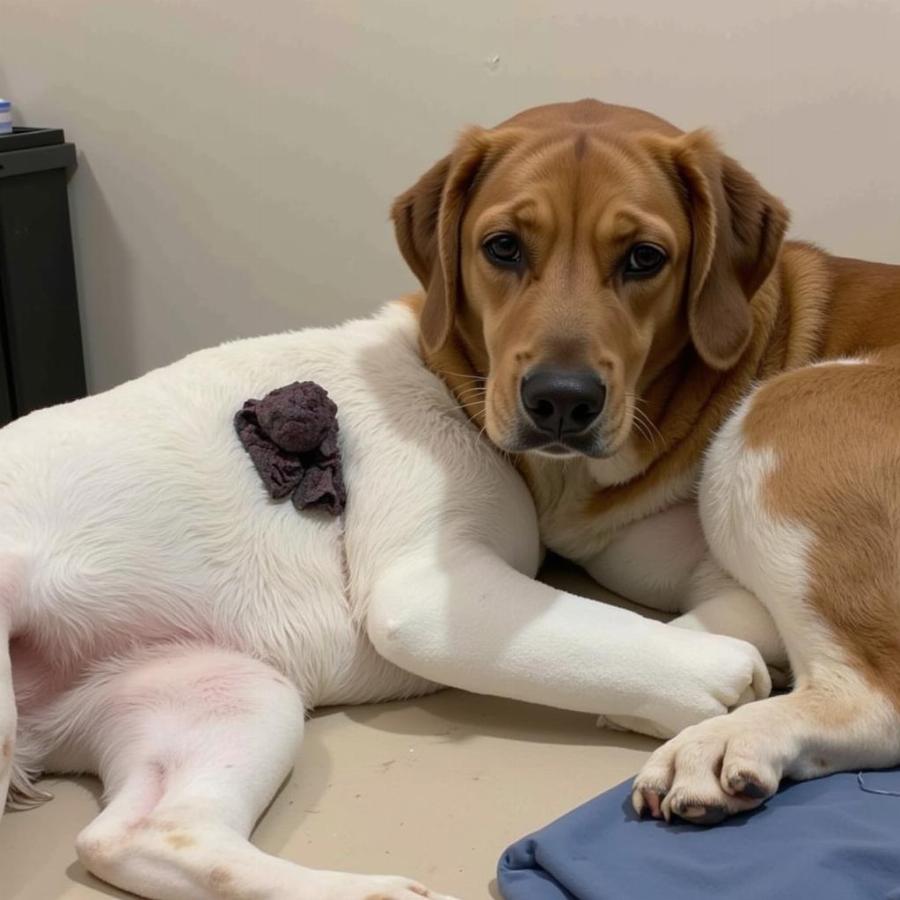Scrotal ablation in dogs, also known as scrotal removal, is a surgical procedure involving the removal of the scrotum, the skin sac that holds the testicles. While often associated with castration, it’s important to understand the distinctions and implications of this procedure. This article will provide a comprehensive overview of scrotal ablation in dogs, covering everything from its purpose and procedure to recovery and potential complications.
Understanding Scrotal Ablation
Scrotal ablation is typically performed in conjunction with castration, especially in cases of testicular tumors, trauma, or infection. It may also be necessary if the scrotum itself is affected by a condition such as severe dermatitis or neoplasia. While castration alone removes the testicles, scrotal ablation removes the entire scrotal sac. This procedure eliminates the risk of future scrotal problems.
Why is Scrotal Ablation Performed?
Several reasons might necessitate scrotal ablation in dogs. These include:
- Testicular Tumors: Removing the scrotum along with the testicles can help ensure complete removal of cancerous tissue.
- Trauma or Injury: Severe trauma to the scrotum might require its removal to prevent infection or further complications.
- Infection: Chronic or severe infections of the scrotum that are unresponsive to other treatments might necessitate ablation.
- Scrotal Dermatitis: In cases of severe, chronic skin inflammation of the scrotum, ablation can provide relief and prevent recurrence.
- Neoplasia: Cancerous growths affecting the scrotal skin itself may require complete removal of the affected tissue.
The Scrotal Ablation Procedure
Scrotal ablation is performed under general anesthesia. The veterinarian will make an incision around the base of the scrotum and carefully dissect the skin away from the underlying tissues. Once the scrotum is detached, the incision is closed with sutures. The procedure is typically relatively straightforward, though the complexity can vary depending on the underlying reason for the ablation.
 Dog Recovering After Scrotal Ablation
Dog Recovering After Scrotal Ablation
Recovery from Scrotal Ablation
Post-operative care is crucial for a smooth recovery. The veterinarian will provide pain medication and antibiotics to prevent infection. The surgical site should be kept clean and dry, and an Elizabethan collar may be necessary to prevent the dog from licking or chewing at the incision. Most dogs recover fully within a few weeks.
Potential Complications
While generally safe, scrotal ablation, like any surgical procedure, carries potential risks. These include:
- Infection: Although antibiotics are typically administered, infection can still occur.
- Bleeding: Excessive bleeding is rare but possible.
- Swelling: Some swelling is normal, but excessive swelling can indicate a problem.
- Wound Dehiscence: In rare cases, the surgical incision may open.
Frequently Asked Questions about Scrotal Ablation in Dogs
- Is scrotal ablation painful for dogs? The procedure is performed under general anesthesia, so the dog does not feel any pain during the surgery. Pain medication is provided post-operatively to manage discomfort.
- How long does it take for a dog to recover from scrotal ablation? Most dogs recover fully within a few weeks.
- Are there any long-term effects of scrotal ablation? Scrotal ablation does not typically have any long-term adverse effects.
- Is scrotal ablation the same as castration? No, castration removes the testicles, while scrotal ablation removes the entire scrotum.
- Can scrotal ablation be performed on all dog breeds? Yes, it can be performed on any breed, though the specific procedure may vary.
- What should I expect after my dog’s scrotal ablation surgery? Your veterinarian will provide detailed post-operative care instructions.
- When should I contact my veterinarian after scrotal ablation? If you notice any signs of infection, excessive bleeding, swelling, or wound dehiscence, contact your veterinarian immediately.
What to Consider After Scrotal Ablation in Dogs
After your dog’s scrotal ablation, ensure they receive proper post-operative care and monitor for any complications. Regular checkups with your veterinarian are essential for ensuring complete healing.
Conclusion
Scrotal ablation in dogs is a surgical procedure that can be necessary for various reasons, including testicular tumors, trauma, and infection. Understanding the procedure, recovery process, and potential complications can help owners make informed decisions and provide the best possible care for their canine companions.
Expert Insight:
- Dr. Emily Carter, DVM: “Scrotal ablation is a safe and effective procedure when performed by a qualified veterinarian. Proper post-operative care is crucial for a smooth recovery.”
- Dr. Michael Davis, DVM, DACVS: “In cases of testicular cancer, scrotal ablation can help ensure complete removal of cancerous tissue, reducing the risk of recurrence.”
Beaut Dogs is your trusted source for all things dog-related. We offer expert advice and resources on various topics, from breed selection to healthcare. For personalized guidance and support, contact us at Email: [email protected]. Beaut Dogs is here to help you navigate the wonderful world of dog ownership.